 Topics
Topics
 excel
excel
 Tips for learning Excel functions: Use the Column function to make formulas more flexible!
Tips for learning Excel functions: Use the Column function to make formulas more flexible!
Tips for learning Excel functions: Use the Column function to make formulas more flexible!
Many times, the difference between multiple formulas is just the column parameters. It would be too clumsy to manually modify the column parameters after copying or filling in the formula. You can use the Column function to make column parameters, making the formula more flexible and easier to use.

When I first learned VLOOKUP, whenever I encountered multiple columns of data, my method of operation was to manually change the third parameter in the formula one by one. For example, below I need to find the student's gender and scores in each subject. My past operations are as follows.
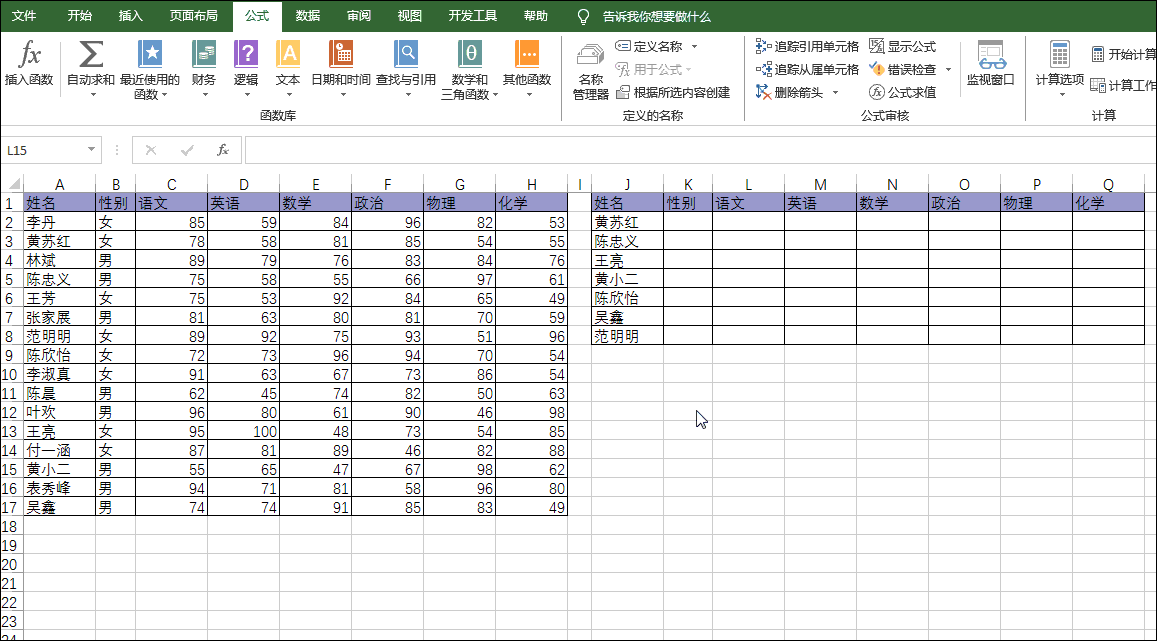
Are there any classmates who operate as stupidly as me? Please raise your hand


#If there are many matching columns, manual modification like mine would be not only error-prone, but also particularly inefficient. So what's the solution?
Yes, use the COLUMN function to replace the column parameters in the formula.
1. COLUMN function
Let’s briefly talk about the meaning and usage of the COLUMN function.
The COLUMN function is used to obtain the column number, using the format COLUMN(reference), where Reference is the cell or cell range whose column label needs to be obtained. There are three typical uses.
1.COLUMN()
The parameter is empty, COLUMN() returns the column coordinate value of the cell where the formula is located, the following formula is located in cell B7, so the return value is 2.
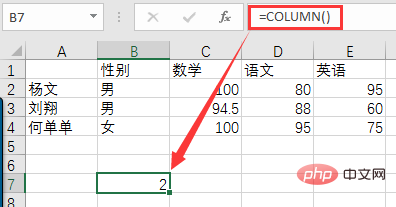
2. COLUMN(C4)
The parameter is a specific cell, such as COLUMN(C4), return C4 Column number 3 is as follows.

3. COLUMN(A2:E6)
The parameter is a cell range, such as COLUMN(A2:E6), return The column number value of column 1 in the area (the column where A2 is located) is 1, as follows.
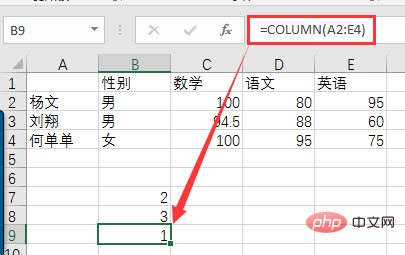
2. Use COLUMN to replace the third parameter of VLOOKUP
Now go back to the previous page to find the student’s gender and In the case of scores for each subject, VLOOKUP and COLUMN are nested. The formula in cell K2 is changed from "=VLOOKUP($J:$J,$A:$H,2,FALSE)" to "=VLOOKUP($J:$J,$A:$H, COLUMN(B2), FALSE)", and then right-click this formula to directly match the other 6 values, without having to manually modify the third parameter one by one. When you pull the formula to the right, you will find that the third parameter automatically changes to COLUMN(C2), COLUMN(D2), COLUMN(E2), COLUMN(F2), COLUMN(G2), COLUMN(H2). Please see the demonstration effect↓↓↓
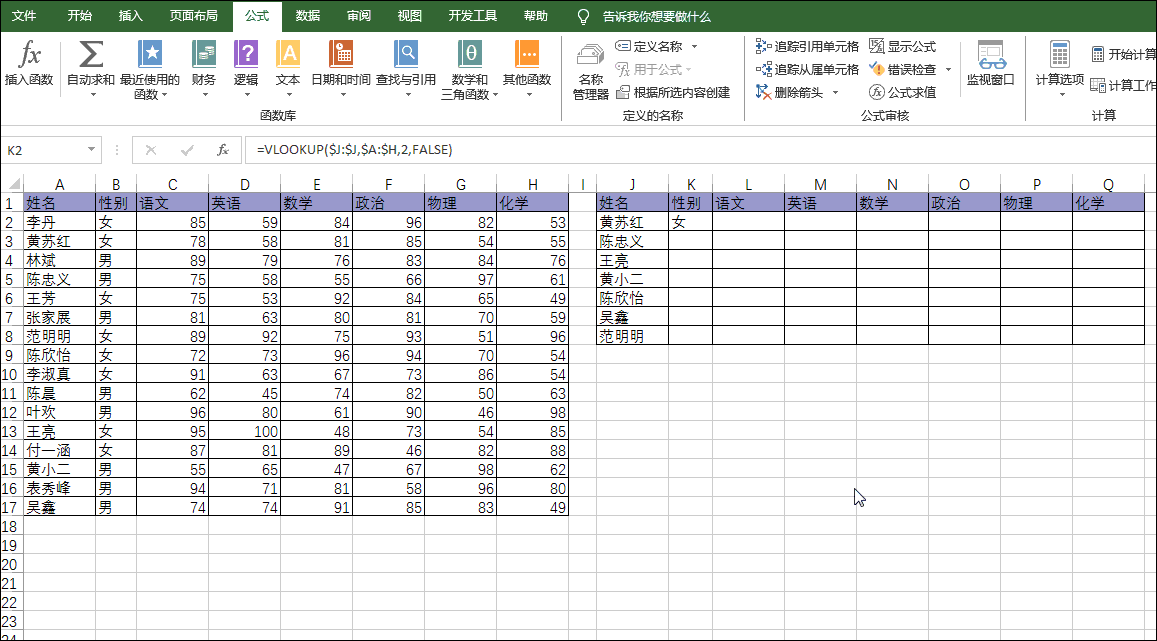
Is the efficiency much higher and less prone to errors? Especially useful when the amount of data is large.
3. VLOOKUP COLUMN quickly fills in salary slips
The nesting of Vlookup and COLUMN functions can also be used to create salary slips, and The greater the number of employees, the easier it is to use this method. The following table is the salary table of some employees of a company. Now we want to make it into a salary slip. How to complete it?
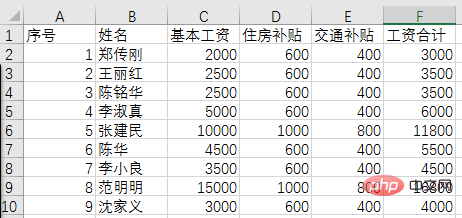
(1) You can copy the table list title in the H1:M1 area.
(2) 9 employees, each with 3 lines of salary slip, a total of 27 lines are required. Select G1:G27, enter any input number and press Ctrl Enter key to fill. This column is prepared for double-clicking to fill down, so as to avoid the inconvenience of dragging down to fill when there are many employees.
(3) Enter serial number 1 in cell H2, and then enter the formula in cell I2:
=VLOOKUP($H2,$A$2:$F$10,
COLUMN(B2),)
(4) Pull right to fill in the formula.
(5) Select the H1:M3 area, double-click the fill handle (small square) in the lower right corner and fill it down to complete the production of the salary slip.
Please see ↓↓↓ for operation demonstration
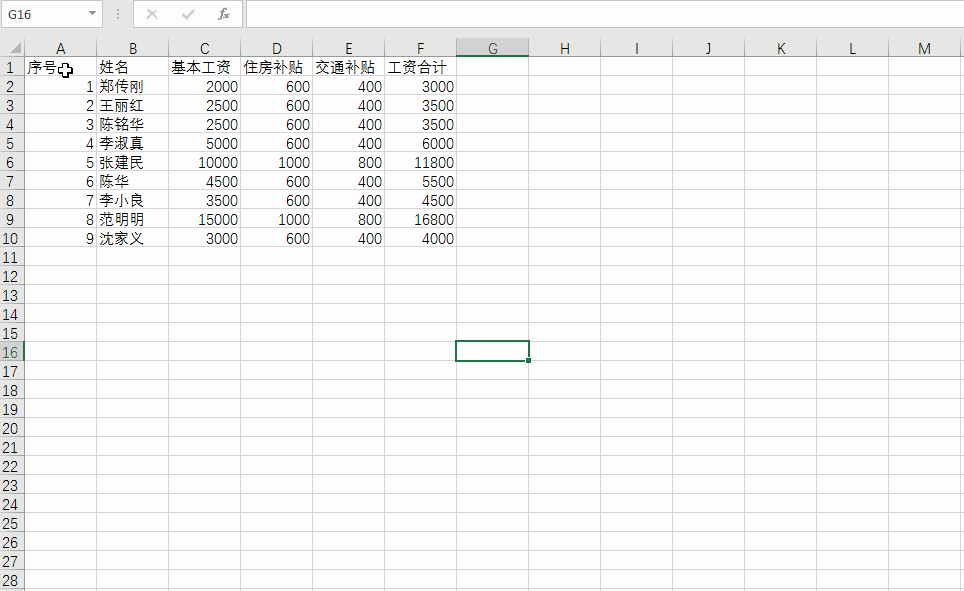
In addition, the nested use of Vlookup and COLUMN functions can also be used to adjust the sorting of table contents. ,
4. Vlookup COLUMN nesting adjusts the data order according to the template
There are two monthly product sales tables. The order of the products in Table 1 is correct and it is a template. The product order in Table 2 has been disrupted. Now it is required to restore Table 2 to the template order. How to achieve this?
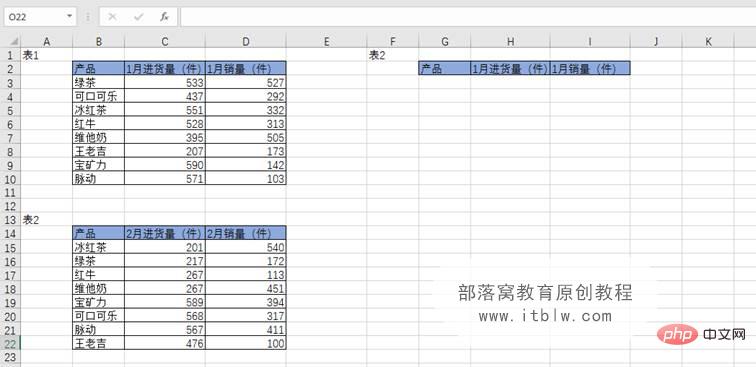
The method that many people think of is to copy and paste the products in Table 1 into a certain area, and then use the Vlookup function formula to search and match the values in Table 2. However, you can actually use Vlookup and COLUMN functions to nest formulas in one step, eliminating the need to copy and paste. Please see the demonstration effect↓↓↓
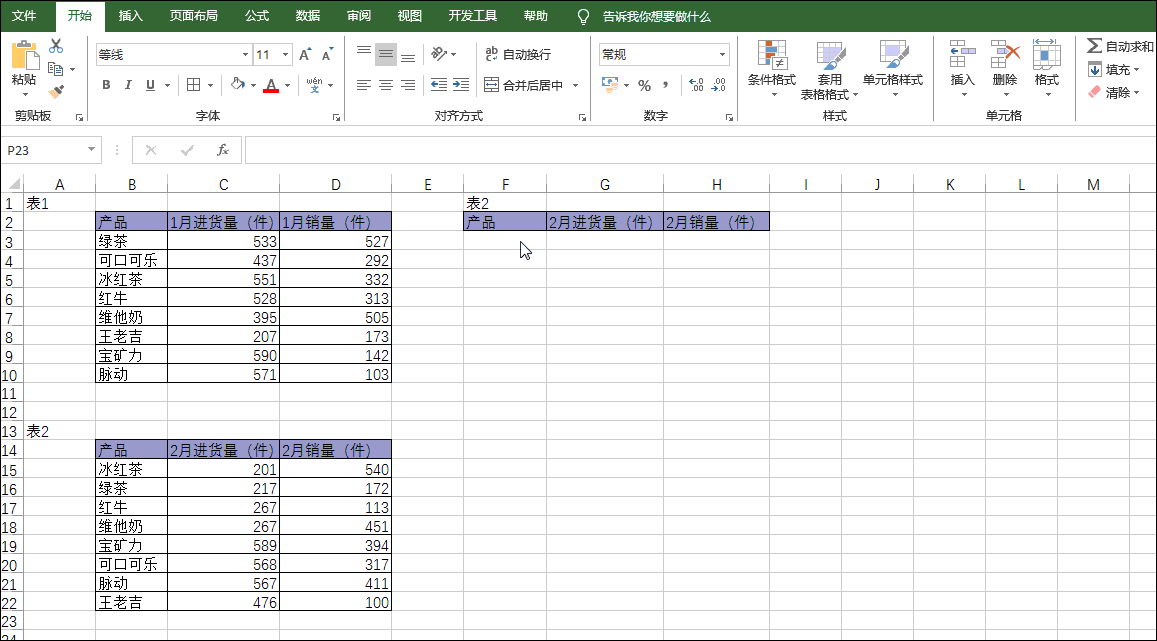
Related learning recommendations: excel tutorial
The above is the detailed content of Tips for learning Excel functions: Use the Column function to make formulas more flexible!. For more information, please follow other related articles on the PHP Chinese website!

Hot AI Tools

Undresser.AI Undress
AI-powered app for creating realistic nude photos

AI Clothes Remover
Online AI tool for removing clothes from photos.

Undress AI Tool
Undress images for free

Clothoff.io
AI clothes remover

AI Hentai Generator
Generate AI Hentai for free.

Hot Article

Hot Tools

Notepad++7.3.1
Easy-to-use and free code editor

SublimeText3 Chinese version
Chinese version, very easy to use

Zend Studio 13.0.1
Powerful PHP integrated development environment

Dreamweaver CS6
Visual web development tools

SublimeText3 Mac version
God-level code editing software (SublimeText3)

Hot Topics
 1377
1377
 52
52
 What should I do if the frame line disappears when printing in Excel?
Mar 21, 2024 am 09:50 AM
What should I do if the frame line disappears when printing in Excel?
Mar 21, 2024 am 09:50 AM
If when opening a file that needs to be printed, we will find that the table frame line has disappeared for some reason in the print preview. When encountering such a situation, we must deal with it in time. If this also appears in your print file If you have questions like this, then join the editor to learn the following course: What should I do if the frame line disappears when printing a table in Excel? 1. Open a file that needs to be printed, as shown in the figure below. 2. Select all required content areas, as shown in the figure below. 3. Right-click the mouse and select the "Format Cells" option, as shown in the figure below. 4. Click the “Border” option at the top of the window, as shown in the figure below. 5. Select the thin solid line pattern in the line style on the left, as shown in the figure below. 6. Select "Outer Border"
 How to filter more than 3 keywords at the same time in excel
Mar 21, 2024 pm 03:16 PM
How to filter more than 3 keywords at the same time in excel
Mar 21, 2024 pm 03:16 PM
Excel is often used to process data in daily office work, and it is often necessary to use the "filter" function. When we choose to perform "filtering" in Excel, we can only filter up to two conditions for the same column. So, do you know how to filter more than 3 keywords at the same time in Excel? Next, let me demonstrate it to you. The first method is to gradually add the conditions to the filter. If you want to filter out three qualifying details at the same time, you first need to filter out one of them step by step. At the beginning, you can first filter out employees with the surname "Wang" based on the conditions. Then click [OK], and then check [Add current selection to filter] in the filter results. The steps are as follows. Similarly, perform filtering separately again
 How to change excel table compatibility mode to normal mode
Mar 20, 2024 pm 08:01 PM
How to change excel table compatibility mode to normal mode
Mar 20, 2024 pm 08:01 PM
In our daily work and study, we copy Excel files from others, open them to add content or re-edit them, and then save them. Sometimes a compatibility check dialog box will appear, which is very troublesome. I don’t know Excel software. , can it be changed to normal mode? So below, the editor will bring you detailed steps to solve this problem, let us learn together. Finally, be sure to remember to save it. 1. Open a worksheet and display an additional compatibility mode in the name of the worksheet, as shown in the figure. 2. In this worksheet, after modifying the content and saving it, the dialog box of the compatibility checker always pops up. It is very troublesome to see this page, as shown in the figure. 3. Click the Office button, click Save As, and then
 How to type subscript in excel
Mar 20, 2024 am 11:31 AM
How to type subscript in excel
Mar 20, 2024 am 11:31 AM
eWe often use Excel to make some data tables and the like. Sometimes when entering parameter values, we need to superscript or subscript a certain number. For example, mathematical formulas are often used. So how do you type the subscript in Excel? ?Let’s take a look at the detailed steps: 1. Superscript method: 1. First, enter a3 (3 is superscript) in Excel. 2. Select the number "3", right-click and select "Format Cells". 3. Click "Superscript" and then "OK". 4. Look, the effect is like this. 2. Subscript method: 1. Similar to the superscript setting method, enter "ln310" (3 is the subscript) in the cell, select the number "3", right-click and select "Format Cells". 2. Check "Subscript" and click "OK"
 How to set superscript in excel
Mar 20, 2024 pm 04:30 PM
How to set superscript in excel
Mar 20, 2024 pm 04:30 PM
When processing data, sometimes we encounter data that contains various symbols such as multiples, temperatures, etc. Do you know how to set superscripts in Excel? When we use Excel to process data, if we do not set superscripts, it will make it more troublesome to enter a lot of our data. Today, the editor will bring you the specific setting method of excel superscript. 1. First, let us open the Microsoft Office Excel document on the desktop and select the text that needs to be modified into superscript, as shown in the figure. 2. Then, right-click and select the "Format Cells" option in the menu that appears after clicking, as shown in the figure. 3. Next, in the “Format Cells” dialog box that pops up automatically
 How to use the iif function in excel
Mar 20, 2024 pm 06:10 PM
How to use the iif function in excel
Mar 20, 2024 pm 06:10 PM
Most users use Excel to process table data. In fact, Excel also has a VBA program. Apart from experts, not many users have used this function. The iif function is often used when writing in VBA. It is actually the same as if The functions of the functions are similar. Let me introduce to you the usage of the iif function. There are iif functions in SQL statements and VBA code in Excel. The iif function is similar to the IF function in the excel worksheet. It performs true and false value judgment and returns different results based on the logically calculated true and false values. IF function usage is (condition, yes, no). IF statement and IIF function in VBA. The former IF statement is a control statement that can execute different statements according to conditions. The latter
 Where to set excel reading mode
Mar 21, 2024 am 08:40 AM
Where to set excel reading mode
Mar 21, 2024 am 08:40 AM
In the study of software, we are accustomed to using excel, not only because it is convenient, but also because it can meet a variety of formats needed in actual work, and excel is very flexible to use, and there is a mode that is convenient for reading. Today I brought For everyone: where to set the excel reading mode. 1. Turn on the computer, then open the Excel application and find the target data. 2. There are two ways to set the reading mode in Excel. The first one: In Excel, there are a large number of convenient processing methods distributed in the Excel layout. In the lower right corner of Excel, there is a shortcut to set the reading mode. Find the pattern of the cross mark and click it to enter the reading mode. There is a small three-dimensional mark on the right side of the cross mark.
 How to insert excel icons into PPT slides
Mar 26, 2024 pm 05:40 PM
How to insert excel icons into PPT slides
Mar 26, 2024 pm 05:40 PM
1. Open the PPT and turn the page to the page where you need to insert the excel icon. Click the Insert tab. 2. Click [Object]. 3. The following dialog box will pop up. 4. Click [Create from file] and click [Browse]. 5. Select the excel table to be inserted. 6. Click OK and the following page will pop up. 7. Check [Show as icon]. 8. Click OK.



